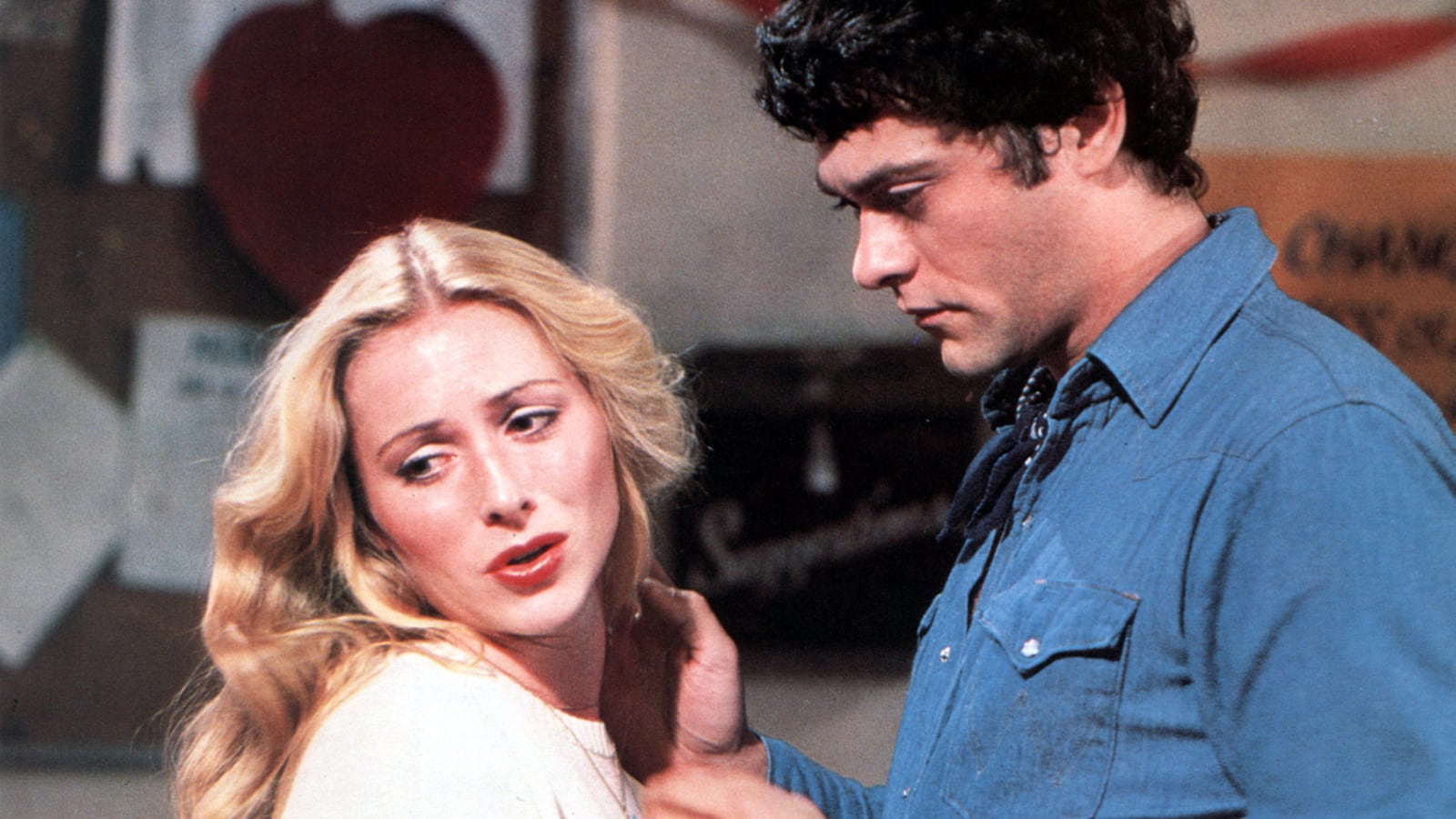Those who are partnered up often view Valentine’s Day as a duty. Don’t forget it, try not to get what you got them last year, and be careful not to burn your place down with those romance-stoking candles after the quaffing of the wine. If you’re single, Valentine’s Day can represent how hard it is to meet someone in an age where people are often more intent on collecting compliments than finding connection. Throw in COVID, and the land is dotted with solo sessions.
Given the eh, fuck it mood toward the so-called holiday this year, there may be no better time to revisit 1981’s My Bloody Valentine, the Canadian gore-fest directed by George Mihalka that achieved instant infamy upon its release from Paramount Pictures 40 years ago.
The early ‘80s were the best time for slashing, drilling, flaying serial murderers with shadowy identities—so the bloodletting came packaged in a quasi-mystery—and kids who pawed each other with a horny fervor. We don’t have rowdy teens in My Bloody Valentine, but rather a pack of miners who behave like teenage boys. They live in a town called Valentine Bluffs, and if you live in Valentine Bluffs, where the highlight of the week is not dying a mile underground choking on gas, I suppose you try and get super-excited for February 14. What that means here is that the washers and dryers at the laundromat are decked out in heart-shaped cardboard cutouts, and there’s going to be a dance—the first Valentine’s dance in 20 years—because the last time there was an explosion in the mine, leaving only one survivor, Harry Warden. Trapped with the bodies of his mates all around him, Harry eventually became Hungry Harry, and ate his pals. What are you going to do, right?
Conceptually it’s a grisly idea, which turns silly when we’re clued in on Harry’s eventual rescue (Valentine’s Day is a major trigger for him). Harry kills a couple mine supervisors who had left him in the lurch and swears death to all who dance on Valentine’s Day, ending up in an asylum, where he dies. Or does he?
A rampaging miner commences the de rigueur stalking, looking like a cross between the Gorton’s fisherman and Black Manta (with a wheezing problem demanding Darth Vader’s allergist). The dialogue is an homage to Ed Wood minimalism, if one is generously inclined. “These are terrible murders,” the town coroner opines after looking at a human heart that has been stuck in a heart-shaped candy box. My Bloody Valentine walks that line between comedy and horror that goes all the way back to James Whale’s 1932 picture The Old Dark House and 1948’s Abbott and Costello Meet Frankenstein. Those are more artful ventures, certainly, and when you mix gore and yucks without deft cleverness, you tend to end up with something overripe, but that’s a paradoxical strength of My Bloody Valentine. It’s hammy, but unabashedly so, which makes it plucky. You respect its attitude.
If you’re frustrated in love yourself, and tired of being on your own because of a virus—and perhaps worried that you’d be on your own in the same way even if COVID wasn’t a thing—it’s not hard to rally behind a movie that is one big shrug of acceptance; a comforting acceptance that we don’t always have to put ourselves through the paces we feel we have to in order to think that we’re loved.
You need a solid finger-wagger—a scold with a vatic edge—in movies like this, and here it’s the bartender at the local hangout, the Cage, who is a dead-ringer for Mr. Roper in Three’s Company. Our man—Happy, as it were (I think it’s a Snow White and the Seven Dwarfs miner joke)—played by Jack Van Evera, speaks entirely in pious sermons of how much everyone else sucks. He’s a shamer who just happens to pour watery beer and shout at clouds with lines like, “This ain’t no fairy tale, little girl.” The movie is clunky, but anyone versed in horror will recognize elements that lived on in The Thing (the unlikely horror setting, for example) and I Know What You Did Last Summer (the epistolary element—there are a lot of menacing notes in My Bloody Valentine). Clunky, but also ambitious in a low-key way, it’s a film that wants to chill with you more than scare you. The chill extends to the cold comfort that, hey, at least you’re not one of these miners locked in what’s tantamount to a Groundhog Day-version of Valentine’s Day.
A beleaguered cop—Don Francks’ Chief Newby—is on the case, but he’s no Chief Brody from Jaws. Call him serviceable, but when you have a movie where the police chief shouts about the need to take down decorations—fucking cardboard—it’s tough not to have him come across as the kindergarten teacher after the holidays who doesn’t want to do the clean-up on their own. Coming-of-age teen and post-teen films are part of the movie’s vocabulary. There’s a lot of Porky’s bromance stuff, and the over-simplified male camaraderie that would become a staple in films like Youngblood. One of the first scenes features the boys showering down after a day of inhaling coal dust, like a Playgirl shoot that doesn’t quite materialize. Everyone seems to live within each other’s armpit, in a manner of speaking—you know who you know, and you won’t know anyone else. But still, there’s the human need for connection, and we watch as these characters seek it out as best they can.
But it’s bleak, man. Dudes in their late twenties and early thirties—I think that’s how old they’re supposed to be—hang out on frigid nights at the junkyard drinking whiskey and blowing on harmonicas. They don’t have a whole lot going for them, and you could say that the movie doesn’t either, but it’s inspirited, which is why My Bloody Valentine has endured as it has.
There isn’t exactly a cornucopia of awesome Valentine’s-related pictures, but for a holiday so steeped in expectations, it’s nice to have a reprieve, and to simply let things be what they are. I’m not suggesting that My Bloody Valentine is Pascal-level philosophy, but it has a knack for easing some of the pressure of where we feel we ought to be in matters of the heart. Call it Valentine’s Day balm for those requiring it; a de-stressor. Not a hard movie with which to bond. But it was a hard movie to get released and marketed. Paramount Pictures was the studio that had brought the world Friday the 13th the year before, with a backlash that was beneficial for business with that particular movie but an albatross for My Bloody Valentine, a sort of sister film, only exchange the Hanniger Mines for Camp Crystal Lake and packed snow for bedewed banks. Shot in the fall of 1980 in Nova Scotia and released three days before Valentine’s Day, My Bloody Valentine had initially been saddled with an X rating. Good luck on the box office front, in other words.
Trims were made, and to this day, no one has seen the full cut. Watching the movie now, beholding the various execution-style deaths, we might find the violence quaint, even risible—as when bobbing hot dogs (some rather on-the-nose symbolism) float up around the face of a guy who’s had his head stuck in a pot of boiling water. The influence of the Beatles didn’t know much in the way of bounds, but you probably wouldn’t think it extended to Canadian slasher films. There was no video of John Lennon being murdered outside his Dakota apartment on Dec. 8, 1980, but the idea of that gruesome death, as it played out in the collective imagination, was sufficiently strong that a movie of mindless killing was to be censored until the news cycle turned over again.

Helene Udy in the Paramount Pictures film My Bloody Valentine
Michael Ochs Archives/GettyOne result is that My Bloody Valentine has never lacked for loyalists. Quentin Tarantino cites it as his favorite slasher film, and the movie has its own brand of romance with its devotees. Those kids-who-are-not-kids refuse to miss out on the Valentine’s fun after their dance is cancelled, so they do what a bunch of irresponsible people are now doing: they throw a party of their own after being told they shouldn’t, with that party being held beneath the earth, in mine shafts. When the My Bloody Valentine crew showed up at the mines they had booked for filming, they discovered that the owners had done a remarkable cleaning job, so a lot of effort went into making the mines look like mines look. And the tight settings work—the movie induces that sensation you feel when someone sits too close to you on an otherwise empty subway car.
We get a love triangle, and lots of sharp cinematography of days as gray, dulled, and dirty as a scuffed nickel. It’s a mood piece that seeps into you, the droll humor akin to Mystery Science Theater wisecracks that happen to be a part of the unfolding movie, baked right into the celluloid. The ending is…well, it’s almost beside the point. The big unmasking comes complete with a groan-inducing pun, but l like I said, sometimes fuck it is what you need. You have to respect My Bloody Valentine because it bears itself with some dignity. Earnestness is a winsome quality. It’s ingratiating. The traditions of this town are sufficiently low-rent that they could be jettisoned, but these people want something to look forward to. The holiday itself almost isn’t germane.
And that to me is the rub of Valentine’s Day. You’re looking forward to something, whether that’s because of what you have, and you’re keen to see it grow, or what you’re lacking and wish to find. In the meantime, settle in, take the night off, and turn on My Bloody Valentine.


